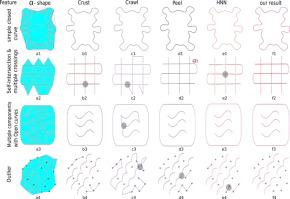Computer Aided Geometric Design ( IF 1.3 ) Pub Date : 2020-12-15 , DOI: 10.1016/j.cagd.2020.101953 Safeer Babu Thayyil , Jiju Peethambaran , Ramanathan Muthuganapathy

|
In this paper, we propose a Delaunay triangulation based algorithmic framework for the 2D point set type discernment and its reconstruction. The point set discernment deals with determining whether the given point set S consists of only the points sampled along the boundary of an object (referred to as boundary sample) or S is distributed across the object (referred to as dot-pattern). In general, the existing approaches deal with the reconstruction of an a priori known input type - boundary sample or dot-pattern. Our approach works on both sets of input data type by first identifying the input type that a given point set belongs to. To distinguish the point set type, we introduce the notion of Petal-Ratio(PR) which captures the ratio of the longest edge to the smallest edge emanating from a vertex in Delaunay triangulation. Further, we employ the Petal-Ratio as the essence to design simple reconstruction algorithms pertaining to each input type that unveil the shape of the object hidden in the given point set. The reconstruction algorithms start with computing the Delaunay triangulation of the given point set and for each vertex, the Petal-Ratio is calculated. Following this, the edges are removed based on the value of the PR for every vertex to arrive at the boundaries. Theoretical analysis of determining appropriate values of PRs under ϵ- sampling and minimal reach sampling models have been presented. Unlike many other algorithms, our approach is non-parametric and non-feature specific that can capture features like disconnected components, multiple holes even with the presence of outliers, self-intersection (only for boundary sample) and open curves (only for boundary sample). Moreover, our algorithms take only one pass to reconstruct the hole boundaries as well as outer boundary irrespective of the object features like the number of holes and the number of components. The comparative analysis shows that our algorithms perform equally well or better than their counterparts for the objects with contrasting features. We also demonstrate that the proposed idea can be easily extended to surface reconstruction.
中文翻译:

用于重构R 2中的点集的采样类型识别方法
在本文中,我们提出了一种基于Delaunay三角剖分的2D点集类型识别和重构算法框架。点集识别处理确定给定点集S是否仅包含沿对象边界采样的点(称为边界样本)或S是否分布在对象上(称为点图案)。通常,现有方法处理先验已知输入类型的重建-边界样本或点模式。通过首先确定给定点集所属的输入类型,我们的方法适用于两组输入数据类型。为了区分点集类型,我们引入“花瓣比率”(PR),它捕获了Delaunay三角剖分中某个顶点发出的最长边与最小边之比。此外,我们以Petal-Ratio作为本质来设计与每种输入类型有关的简单重构算法,这些算法揭示了隐藏在给定点集中的对象的形状。重建算法首先计算给定点集的Delaunay三角剖分,并为每个顶点计算Petal-Ratio。然后,根据每个顶点的PR值删除边缘,以到达边界。确定ϵ下PR s合适值的理论分析-提出了抽样和最小范围抽样模型。与许多其他算法不同,我们的方法是非参数和非特征特定的,可以捕获诸如断开的组件,即使存在异常值也存在多个孔,自相交(仅适用于边界样本)和开放曲线(仅适用于边界样本)等特征)。此外,我们的算法仅需一次通过即可重建孔边界以及外部边界,而与对象特征(例如孔的数量和组件的数量)无关。对比分析表明,对于具有对比特征的对象,我们的算法在性能上要优于或优于同类算法。我们还证明了所提出的想法可以轻松地扩展到表面重建。









































 京公网安备 11010802027423号
京公网安备 11010802027423号